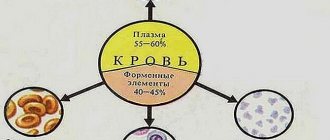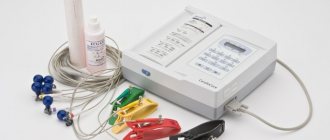What is this procedure
To understand what thrombolysis treatment is, let’s pay attention to the constituent words. The name stands for thrombus lysis.
In a healthy person, special blood enzymes are involved in the destruction of a blood clot, but in a number of diseases the protective forces fail and artificial or artificial thrombolysis is required.
The need for lysis or dissolution of thrombus formation occurs in the following cases:
- a broken blood clot completely blocks the lumen of the vessel, preventing blood supply to the tissues;
- the accumulation of blood clots impedes vascular blood flow.
Thrombolytic therapy aims to eliminate blood clots using medications. Agents that eliminate platelet aggregation are administered intravenously or inside a thrombosed vessel.
Types of thrombolysis
Depending on the site of administration of the drugs necessary for thrombolysis, doctors distinguish between systemic and local methods. Each method has disadvantages and advantages.
System
Thrombolytic drugs are administered to the patient into a vein in the elbow.
The advantages of the method are as follows:
- general blood thinning;
- the ability to dissolve a blood clot in a hard-to-reach area;
- ease of manipulation (can be performed both in a hospital setting and as first aid for acute thrombosis).
Disadvantages include the need to administer thrombolysis drugs in maximum therapeutic doses. Such medicinal effects negatively affect the general condition of the blood.
Local (selective)
Drugs that eliminate thrombosis are injected into the vessel where the blood clot is located.
Pros of introduction:
- the therapeutic effect is achieved in a short time;
- there is no need to administer large doses of medications;
- drugs have less effect on overall blood clotting;
- effective 6 hours after cessation of blood flow to tissues.
Selective thrombolysis has one drawback - a specially trained specialist is required to carry out the intervention. The procedure is performed by a doctor, inserting a catheter under the control of an ultrasound machine.
Thrombolytic treatment is also divided into types according to the properties of the administered medications:
- generalized (medicines with a broad spectrum of action are used);
- selective (use medications with a narrowly targeted effect).
Which method will be used is selected individually. The choice is influenced by the time elapsed since thrombosis, the nature of vascular disorders and many other factors.
Types of TLT
Thrombolysis therapy is done in two ways. However, the operating principle is the same. Thrombolytics are administered - this is a medication that thins the blood. They differ only in the method of introducing the drug into the body.
Thrombus lysis can be systemic or local. The first is larger-scale, and the second concentrates on specific foci: vessels containing a blood clot. Each method has its own disadvantages and strengths. Only after consultation, doctors prescribe thrombolysis. Indications and contraindications for each method apply separately to each patient.
System view of TLT
Systemic thrombolysis is an extensive technique of the procedure. The drugs are injected into a vein in the elbow and spread evenly throughout the circulatory system. The advantages of this type of thrombolytic therapy:
- Decreased hematocrit (HCT). It is responsible for the thickness of the blood.
- Thinning of blood in the body. This eliminates blood clots in hard-to-reach areas.
- A simple method of therapy. It can be carried out in various conditions: hospital, emergency care, dispensary treatment.
Attention! A serious disadvantage of systemic TLT is the detrimental effect of a large dose of medication on blood composition. A significant amount of thrombolytics is injected into a vein so that they do not accumulate in the body.
Local (selective) type of TLT
Selective thrombolysis can only be performed by a competent doctor. A catheter with medication is inserted into the site of the blood clot and is monitored through an ultrasound machine. This method allows for targeted removal of blood clots without using medications for the entire body. Reasons for choosing selective TLT:
- the ability to quickly achieve results;
- minimizing harm from medications to the body, using small doses;
- drugs contribute less to reducing blood density.
The main disadvantage of selective thrombolysis is the shortage of doctors capable of performing the procedure.
Indications for thrombolysis
Any significant disturbances in blood flow caused by the formation of a blood clot inside a vessel.
Thrombolysis is indicated in the following cases:
- Myocardial infarction (AMI). Thrombolytic therapy for myocardial infarction is carried out to prevent the re-formation of blood clots and increase blood flow. Indications for thrombolysis in myocardial infarction are the first hours after the attack. If AMI occurred 6 or more hours ago, then thrombolytics are not administered, but medications with a blood-thinning effect from other groups are prescribed.
- Stroke. Thrombolysis for ischemic stroke is used relatively often. But for a stroke caused by a ruptured vessel (hemorrhagic), the procedure is not used due to the risk of increased bleeding.
- TELA. Pulmonary thrombosis is a life-threatening condition. With pulmonary embolism, blood circulation in the pulmonary circulation stops and the person dies from lack of oxygen. Indications for thrombolysis for pulmonary embolism are blockage of a pulmonary artery by a thrombus.
- Acute coronary syndrome (ACS). Most people mistakenly consider this term to be synonymous with myocardial infarction. But with ACS, not only the myocardium suffers: rhythm and hemodynamics are disrupted. The cause of coronary syndrome can be acute myocardial ischemia, an attack of unstable angina and some other cardiac disorders. Indications for thrombolysis in patients with ACS are related to the presence of a thrombus in the coronary arteries. A heart attack is considered a form of ACS.
- Acute forms of thrombophlebitis. In patients with acute venous thrombosis, thrombolysis can reduce the severity of the condition and improve blood flow in the extremities.
For thrombolytic therapy, indications relate to obstruction of veins or arteries due to blood clots. In addition to the listed conditions, it is possible to use thrombolytics for other diseases accompanied by the appearance of intravascular blood clots.
Indications and contraindications for TLT
Indications for thrombolysis consist of a number of diseases. If they are present, the formation of a blood clot becomes especially dangerous:
- If the patient experienced an attack a few hours ago, he is prescribed TLT to increase blood flow. When more than half a day has passed since the heart attack, instead of TLT, drugs with a blood-thinning composition are prescribed.
- When suffering an ischemic stroke, thrombolytics are used for the same purpose of liquefying the blood clot.
- Thrombosis of any form, but experts distinguish pulmonary artery thrombosis separately. The pulmonary artery becomes blocked and the person dies from lack of air. In this case, thrombolysis solves the problem quickly.
- Acute coronary syndrome (ACS) is the reason for TLT. In this case, angina pectoris, ischemia and other complications are observed. The coronary artery is examined to determine the location of the blood clot.
- It is used in cases of arterial embolism, stenosis and thrombophlebitis.
Attention! With a hemorrhagic stroke, there is a risk of only increasing or causing bleeding. Therefore, thrombolysis therapy is strictly not used for this type of stroke.
Contraindications to thrombolysis are numerous. Doctors will not prescribe the procedure for the following reasons:
- naturally low hematocrit values;
- pregnancy or breastfeeding;
- aneurysm;
- kidney or liver failure;
- allergies, other forms of drug intolerance;
- recent operations;
- patient over 70 years of age: risk of hemorrhage;
- diabetes;
- hypertensive crisis;
- ulcers on the mucous membrane of the digestive tract.
Doctors prohibit TLT in other cases. If, when a patient has suffered a myocardial infarction, he also suffers from atherosclerosis. Or more than half a day has passed since the attack. Even if ACS is included in the indications for TLT, it is not used in 100% of cases. When there is no thrombus in ACS, there is no need for therapy.
Contraindications to thrombolysis
When prescribing thrombolysis, the doctor takes into account indications and contraindications. Thrombolytic therapy is prohibited in the following cases:
- hypertensive crisis;
- recent operations (risk of internal bleeding at the surgical site);
- blood diseases;
- age over 70 years (vessels become fragile and hemorrhages may develop);
- the presence of benign or malignant neoplasms;
- tendency to bleeding (low blood clotting);
- diabetes;
- recent TBI (up to 2 weeks from the date of receipt);
- pregnancy;
- breast-feeding;
- ulcerative lesions of the digestive tract mucosa;
- aneurysm of any location;
- liver or kidney failure;
- individual intolerance to medications.
Even if the above contraindications are not identified, there are the following prohibitions for carrying out the procedure in acute conditions:
- With AMI. Conditional contraindications to thrombolysis for myocardial infarction are the presence of atherosclerosis in the patient or more than 6 hours have passed since the attack. Thrombolysis for a heart attack in these cases will be poorly effective.
- With ACS. Acute coronary syndrome occurs for various reasons, and a contraindication to thrombolytic therapy in patients with ACS is the absence of thrombosis.
- For a stroke. Thrombolysis therapy is not always necessary for patients with stroke. If it is undesirable to perform a procedure during an ischemic stroke, if a lot of time has passed since the attack, then thrombolysis for a hemorrhagic stroke is dangerous due to increased intracranial hemorrhage.
- With pulmonary embolism. There are no contraindications. With this pathology, there is a pronounced disturbance or complete cessation of pulmonary blood flow, and without medical assistance, pulmonary thromboembolism ends in death. Thrombolysis helps save lives.
But all contraindications are relative. Often, in severe cases, doctors use thrombolysis for pulmonary embolism or large heart attacks without specifying the list of prohibitions. This is due to the fact that the patient’s vital signs sharply deteriorate, and the administration of thrombolytics helps to avoid death.
Contraindications to TLT in case of ox
Thrombolysis
Indications for thrombolysis ( elderly age is not a contraindication ) • ECG reveals a rise in the ST interval of more than 1 mm in two or more adjacent leads (if anterior MI is suspected) or in 2 of 3 limb leads II, III, avF (if anterior MI is suspected) to inferior MI), or the presence of LBBB (probably when subtotal coronary artery occlusion progresses to total), or idioventricular rhythm,
• first 6 hours of myocardial infarction. But if pain persists, ST segment elevation and the absence of the Q wave (when the myocardium is still alive), the first 12 hours are also “suitable”, if the MI has not ended and there is a “mosaic” clinical picture. The decision to perform thrombolysis after 12 hours is made on the basis of clinical pictures, anamnesis and ECG
Thrombolysis for ACS without persistent ST segment elevation (or with T-wave inversion, or no changes on the ECG) is not indicated
Contraindications to thrombolysis (usually associated with the risk of bleeding) • absolute - active bleeding, including bleeding from the gastrointestinal tract over the past month, previous recent (not older than 6 months) hemorrhagic stroke (or a history of subarachnoid bleeding); major surgery, childbirth, serious injury (TBI) in the previous 3 weeks;
• relative - suspected aortic dissection; intracerebral pathology that is not absolute (cerebral circulatory disorders that occurred during the previous 2 months, even with complete restoration of all functions by now); fresh injury; major surgery less than 3 weeks old; internal bleeding; multiple repeated MI with severe post-infarction cardiosclerosis; peptic ulcer in the acute phase; severe liver diseases (liver cirrhosis - liver cirrhosis); hemorrhagic diathesis; glomerulonephritis; blood diseases with bleeding; severe, poorly corrected hypertension (more than 180/110 mm Hg); DM with severe angioretinopathy; possible pregnancy; treatment with oral anticoagulants in therapeutic doses; puncture of vessels that cannot be pressed; recent retinal laser treatment; traumatic or long-term resuscitation (more than 10 minutes); history of an allergic reaction to streptokinase (last 2 years). In these cases, reteplase or tenectoplase is administered.
Treatment methods
As mentioned earlier, there are systemic and selective methods of administering medications. Let's find out which method is better, taking into account the nature of the pathology that has arisen and how it is carried out.
System
They are considered universal. Systemic thrombolysis is done by administering lysing agents through a vein. Indicated in the following cases:
- for stroke;
- with a heart attack;
- with pulmonary embolism.
The convenience lies in the fact that assistance can be provided both in the hospital and at the pre-hospital stage. Clinical recommendations for therapy include monitoring ECG and blood clotting.
Selective
Another name is catheter thrombolysis. In this case, the doctor places a catheter in the vein or artery affected by thrombosis.
How the procedure is performed depends on the location of the blood clot:
- Local thrombolysis for a heart attack is done in the cardiac intensive care unit with an intravenous catheter. The method serves as an alternative to coronary bypass surgery.
- Selective thrombolysis for stroke is rarely performed due to the difficulty of accessing the cerebral arteries. Thrombolytic therapy for ischemic stroke using catheterization is possible only in clinics specializing in helping stroke patients.
- Vein thrombosis. With this pathology, lysis of blood clots is considered one of the simplest. The doctor injects the selected medication into a vein of the limb.
Which method to use is decided individually.
Catheterization of a thrombosed vessel makes it possible to more effectively eliminate the problem, and intravenous infusion of thrombolytics makes it possible to provide assistance more quickly and prevent complications.
Drugs for thrombolysis
Thrombolytic therapy for myocardial infarction, stroke or pulmonary embolism is carried out with various medications. Thrombolytic drugs are selected taking into account the nature of the pathology, but sometimes it is possible to use those drugs that are in the first aid kit (in the ambulance the list of drugs is limited). Let's consider popular drugs for thrombolysis:
- Streptokinase. A classic drug for dissolving blood clots, it is used for myocardial infarction or pulmonary embolism, and less commonly as thrombolytic therapy for ischemic stroke. In case of thrombosis, the medicine has a powerful lysing effect, but greatly thins the blood and increases the permeability of the vascular wall. Streptokinase is considered a thrombolytic with many side effects. Most often used for myocardial infarction and pulmonary embolism.
- Actilyse. Mechanism of action: thrombolytics and fibrinolytics. The components of the drug, reacting with fibrinogen, provoke lysis of the blood clot. Despite the fact that Actilyse is a second-generation thrombolytic drug, the drug produces few side effects and is often used in hospitals. Actilyse and other new generation drugs are considered the most popular products.
- Urokinase. In the 4th generation classification, it is considered a convenient drug for lysing blood clots. When used, it has few side effects, but is expensive.
- Fortelysin. Like Actilyse, it belongs to the second generation (this list of drugs is most popular for the treatment of thrombosis). Fortelysin is considered one of the best drugs for thrombolysis with a small number of adverse reactions.
The names of drugs from the group of 5th generation thrombolytics are not worth listing. These modern drugs have a minimum of contraindications, are well tolerated, but are expensive and are used only in large clinics.
There are no oral agents for thrombolysis - drugs are used only in injection solutions. But some patients mistakenly confuse thrombolytics and anticoagulants (Warfarin), which are available in tablets and are indicated for long-term use.
Indications
There are certain indications for thrombolytic therapy, which the attending physician considers when choosing treatment tactics for the patient. Each case is considered individually, therefore it is extremely important to first undergo a set of diagnostic measures. This will make it possible to understand whether thrombolytics can be used in treatment in this situation, or whether an alternative to thrombolytic therapy should be sought. In modern treatment, TLT is widely used in the fight against diseases that are accompanied by the presence of fibrin blood clots.
Thrombi are divided into venous and arterial, and are also caused by pulmonary, paradoxical or systemic thromboembolism. Recently, thrombolytic drugs have been actively prescribed to patients who have been diagnosed with pulmonary embolism (PE); these drugs demonstrate fairly high effectiveness.
TLT or thrombolysis is important to use for:
- myocardial infarction;
- TELA;
- peripheral and central arterial thrombosis;
- thrombosis of the veins of the liver, kidneys and others (with the exception of the veins of the legs);
- strokes;
- thrombosis of the central retinal vein;
- clogging of implanted valves;
- clot formations in aorto-coronary and other bypass grafts;
- thrombosis of peripheral arteries.
Medical practice clearly shows that thrombolytic therapy for ischemic stroke, heart attacks and various types of thrombosis is highly effective. The indicated indications for thrombolysis must be compared with the contraindications present in each individual patient. Indications and contraindications may contradict each other, that is, there are reasons for TLT, but other health problems do not allow this option of drug therapy. Therefore, contraindications to thrombolytic therapy should be considered separately. To assess the degree of effectiveness of thrombolytic drugs, patients are referred for comprehensive diagnostics. The most informative examination methods are:
- blood analysis;
- electrocardiogram (ECG);
- angiography.
After assessing the condition, the attending physician makes the final decision on the possibility or impossibility of thrombolytic therapy.
Ambulance with thrombolysis for emergencies
The system of emergency measures for ambulance workers contains the following clinical recommendations:
- TELA. If this condition occurs, therapy with thrombolysis agents is indicated, regardless of possible contraindications.
- Stroke. If there is no certainty about the nature of stroke lesions, then the administration of thrombolytics is undesirable. Recommendations for doctors and paramedics indicate that it is better to carry out supportive therapy to eliminate the risk of intracranial bleeding in hemorrhagic stroke.
- AMI. Thrombolysis for myocardial infarction at the prehospital stage will help in the first hours. If more than 6 hours have passed since the attack, then only the administration of narcotic analgesics and delivery of the patient to the hospital is recommended.
All appointments are made by a doctor, and, in some cases, by a paramedic. Before using thrombolysis at the prehospital stage, the possible benefits and harms to the patient are taken into account.
Thrombolysis for acute myocardial infarction
Cardiovascular diseases occupy first place in the general structure of pathology and are the cause of premature death among the population in more than 60% of cases.
Cardiovascular accidents (unstable angina, myocardial infarction) are especially dangerous due to their sudden onset, which is often accompanied by the development of life-threatening complications. Therefore, it is worth starting highly qualified treatment as soon as possible, since the greatest losses occur in the first 2 hours of the disease. The development of AMI (acute myocardial infarction) is based on intracoronary thrombosis at the site of a destabilized atherosclerotic plaque, which leads to cessation of blood supply and the development of necrosis of a portion of the heart muscle. This is a very fleeting process: within 60 minutes from the onset of ischemia, about 50% of cardiomyocytes in the affected area die.
Emergency care for AMI at the prehospital stage should be aimed at:
- adequate pain relief;
- resumption of patency of the damaged vessel, prevention of reocclusion (repeated cessation of blood circulation);
- maintaining the patency of the coronary arteries, reducing platelet aggregation;
- limiting the ischemic zone, preventing or eliminating complications.
What are the complications?
Thrombolytics are considered “heavy” drugs for the human body. Let's consider common complications of thrombolytic therapy:
- fever up to 38° and above;
- acute failure of cardiac function;
- cerebral hemorrhagic hemorrhages (with ischemic stroke);
- heart rhythm disturbances;
- drug-induced hypotension;
- internal and external bleeding.
To avoid unwanted reactions, thrombolysis is carried out under the control of electrocardiography and blood clotting.
How is effectiveness assessed?
How much the procedure helps is assessed using MRI or Doppler ultrasound. Let's consider the main criteria for the effectiveness of thrombolysis:
- Zero. The drugs do not affect the blood clot.
- First. There is a slight lysis of the thrombus structure.
- Second. Blood flow appears, but the bloodstream is partially freed.
- Third. Maximum therapeutic effect - the bloodstream is fully functioning.
Whether thrombolysis is needed or not is decided individually. But if the procedure is necessary, then you should not refuse - resorption (lysis) of the blood clot will improve blood circulation and prevent complications of the disease.











